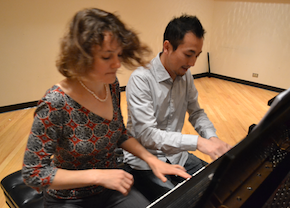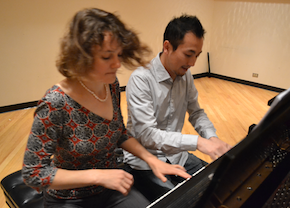
On Sunday afternoon, as a semi-exhausted cast and crew performed wonders on the stage of Lam Research Theater (when will I get used to that name?), the Opera Parallèle Orchestra, squeezed into a shallow, narrow pit, reminding me of some of my best experiences with the music of Kurt Weill and, especially, Francis Poulenc.
When I was impressed and moved by the rehearsal of the Weill/Poulenc double bill of Mahagonny Songspiel and Les mamelles de Tirésias, the accompaniment came from Keisuke Nakagoshi's piano, filling in spectacularly for the orchestra. Once the production moved into Yerba Buena — three backbreaking performances in about 40 hours, taxing the singers to their utmost — the orchestra gave the work a whole new, even deeper and brilliant dimension.
Poulenc's unique sound, with those Straussian stretched-out deceptive faux-dissonances, was thrilling in this performance. The only description possible is from Ned Rorem's Setting the Tone:
Take Chopin's dominant sevenths, Ravel's major sevenths, Fauré's plain triads, Debussy's minor ninths, Mussorgsky's augmented fourths. Filter these through Satie by way of the added sixth chords of vaudeville (which the French call Le Music Hall), blend in a pint of Couperin to a quart of Stravinsky, and you get the harmony of Poulenc.
Of course, top acknowledgment goes to Music Director and Conductor Nicole Paiement. But SFCV has been featuring her so prominently of late that I thought she might want to speak about her musicians, rather than herself, and she agreed readily:
The orchestra had to be extremely nimble in the Poulenc to play such a cubistic score, where texture, tempo, and color change rapidly. Also, combining the Weill and the Poulenc added a demand to the orchestra since they each had a very specific sound world: Weill darker and heavier, Poulenc much lighter, even if the orchestra was twice the size for this piece and the brass doubled.
The concertmaster was Roy Malan, about whom there is a separate item below, paired with Stephanie Bibbo; add the viola of Evan Buttemer, Adaiha MacAdam-Somer on cello, Stan Poplin on contrabass, and there you have the string section of five, which sounded so big and sumptuous.
Nakagoshi was on board once again, along with Nicholas Matthiesen's percussion and Carla Fabris' harp. Woodwinds were relatively numerous: Carmen Lemoine (flute/piccolo), Laura Reynolds (oboe/English horn), Paul Miller and Lara Mitofsky (clarinet), Cory Wright (alto saxophone), and Erin Irvine (bassoon).
The brass acquitted themselves wonderfully, kudos to Alex Rosenfeld (French horn), John Freeman and Kai Takaara (trumpet), Hall Goff (trombone), and Tiffany Bayly (tuba).
Bravi per tutti!

